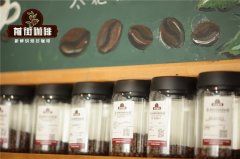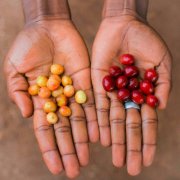Why are Kenyan coffee beans all red? Historical Story and auction Department of Coffee cultivation and production in Kenya

A specific protocol has been established in the processing of beans in Kenya that produces reliable, high quality products. All processing is done by wet methods, which tend to produce cleaner, brighter and more fruity cups.
Kenyan coffee is mostly red because only fully ripe red cherries are selected during the picking process and any damaged or diseased fruit is carefully removed.
Beans undergo a long fermentation process lasting up to 36 hours. This helps remove sticky, sugary coatings, which are then dried and then ground.
Such strict standards are closely related to the history of coffee development in Kenya.

Since before independence, kenya's coffee system has centered on weekly auctions. The Kenya Coffee Board (now Coffee Council) was established in 1933. The following year, a government-run auction system was established. The auction also creates a pricing system designed to reward better quality at better prices.
Today, auctions are widely regarded as the most transparent price discovery mechanism for premium green coffee and are considered one of the best auction systems in the world. It even inspired the Cup of Excellence auction.
New legislation in 2006 and 2018 provided farmers with more opportunities to sell coffee. While the auction system was mandatory until 2006, legislation in 2006 created a "second window" for coffee growers to sell directly to international buyers.
SL-28 and SL-34 are famous Kenyan coffee varieties. They were bred by Scott Agricultural Laboratories (SAL). SAL was established by Kenya's colonial government in 1903 as a research institute for agricultural products.
SL-28 and SL-34 quickly became the preferred varieties for most growers. Their deep root structure helps them capture moisture in the dry environment of most parts of Kenya, even without irrigation. These varieties also have higher yields than traditional French bourbon rootstocks and are thought to have stronger disease resistance.
Although both SL varieties spread very quickly in Kenya, Ruiru-11, released by the Kenya Coffee Research Institute (CRI) in 1985, brought a new child to the neighborhood. Many farmers planted the new Ruiru-11 variety because it was more resistant to coffee berry disease (CBD), a fungal disease that attacks ripe coffee cherries, and coffee leaf rust (CLR), a fungal disease that targets coffee tree leaves. It can also be planted at higher densities than SL varieties, enabling farmers to maximize yields on small plots.
A disadvantage of Ruiru-11 is that its shallower root structure is more susceptible to drought and requires more fertilizer. Farmers found that by grafting Ruiru-11 onto trees of SL varieties, they could have the best of both worlds. Trees grafted with Ruiru-11 on SL variety plants have deeper root structure (due to SL variety) and higher disease resistance and higher yield (due to Ruiru-11) during drought periods.
Other farmers are also experimenting with Batian, a relatively new variety introduced by the Coffee Research Institute (CRI) in 2010. Batian is named after the highest peak on the mountain. Kenya is also resistant to CBD and CLR. This variety has the added benefit of early maturity, starting to bear fruit after only two years. So far, some challenges (such as plant structure) have prevented its widespread spread, but its popularity is certainly growing.
While most farms in Kenya still own traditional SL varieties, most also own Ruiru-11, and increasingly Batian. Most farms are too small to segregate batches by breed. This means that most plots from Kenya-be they single estates or smallholder groups-are a mix of SL, Ruiru-11 and (sometimes) Batang.
Today, more than 600,000 smallholder farmers growing less than five acres make up 99% of Kenya's coffee growing population. Their farms cover more than 75 percent of the total coffee growing area and produce nearly 70 percent of the country's coffee. These farmers are organized into hundreds of farmer cooperatives (FCS), all of which operate at least one factory. The remainder of the annual production is grown and processed on small, medium and large plots. Most of the larger estates have their own washing stations.
Most Kenyan coffee is thoroughly washed and dried on elevated beds. Many washing stations in the country are still known for their high quality and attention to detail. The best plants employ strict classification methods when it comes to cherry intake, and many of them have had the same managers for years.
Important Notice :
前街咖啡 FrontStreet Coffee has moved to new addredd:
FrontStreet Coffee Address: 315,Donghua East Road,GuangZhou
Tel:020 38364473
- Prev

Kenya PB? Flavor and taste characteristics of coffee round beans 8 grades and standards of Kenyan coffee
Peaberry means that one coffee bean grows in a cherry, not two. Because the rounder shape minimizes the sharp edges, it makes it easier for the berries to roll in the baking room and roast slightly more evenly, bringing a very consistent flavor to the coffee. Kenyan round bean coffee tastes similar to Kenyan AA coffee. Kenya round beans (PB) coffee beans are coffee trees
- Next

Cinnamon roasted Kenya AA coffee bean flavor taste Kenyan coffee deep roasted light roasted flavor difference
When ranking the best coffee in the world, only a few important coffee-growing areas are often at the top of the list. One of the most famous countries is, of course, Kenya. Kenyans like all levels of baking, but most people choose light to moderate baking to better emphasize the subtle fruity of beans. Although different classifications (Kenya AA, AB, Dou) do not respond to heating
Related
- Detailed explanation of Jadeite planting Land in Panamanian Jadeite Manor introduction to the grading system of Jadeite competitive bidding, Red bid, Green bid and Rose Summer
- Story of Coffee planting in Brenka region of Costa Rica Stonehenge Manor anaerobic heavy honey treatment of flavor mouth
- What's on the barrel of Blue Mountain Coffee beans?
- Can American coffee also pull flowers? How to use hot American style to pull out a good-looking pattern?
- Can you make a cold extract with coffee beans? What is the right proportion for cold-extracted coffee formula?
- Indonesian PWN Gold Mandrine Coffee Origin Features Flavor How to Chong? Mandolin coffee is American.
- A brief introduction to the flavor characteristics of Brazilian yellow bourbon coffee beans
- What is the effect of different water quality on the flavor of cold-extracted coffee? What kind of water is best for brewing coffee?
- Why do you think of Rose Summer whenever you mention Panamanian coffee?
- Introduction to the characteristics of authentic blue mountain coffee bean producing areas? What is the CIB Coffee Authority in Jamaica?

